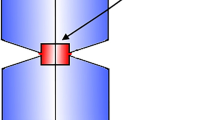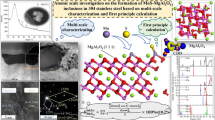Following the experimental data in Part I of this article, the present paper considers existing strengthening mechanisms of dispersion-strengthened alloys, including Ansell–Lenel and Orowan–Ashby models, to explain yield strength increment after inserting incoherent and undeformable second-phase particles into a metal matrix. The influence of the particle type on the structure and flow stress under Ansell–Lenel model was evaluated using iron condensates, which contain the greatest number of combinations within the ‘matrix–neutral particle’ system. The shear modulus values for bulk materials are assumed to apply also to dispersed particles of the same composition when determining a yield strength increase. An increase in yield strength after inserting oxides, carbides, and borides into the metal matrix was inconsistent with the Ansell–Lenel model. In addition, Ansell defines a distance between particles using the volumetric approach to consider the second phase distribution within the matrix. According to the Orowan model modified by Ashby, the yield strength of the matrix with dispersed particles is calculated considering that a planar approach is used to define the distance between particles. This parameter is calculated as a mean value of the shortest distances between surfaces of neighboring particles in a sliding plane. It is shown that a distance between particles determined using a volumetric approach displays lower absolute values at the given volumetric content of the second phase compared to the planar approach. Consequently, the first approach (volumetric) suggests larger incremental values of the yield strength. In this study, a planar approach was also used as more realistic, for evaluating the distance between strengthening particles when estimating the yield strength increment following the Orowan–Ashby model. A model proposed in this work as a prototype of the Orowan analysis uses such parameters as a distance between dislocation clusters generated due to a blocking effect of the second phase and generation of dislocations by interface particle–matrix surface, taking into account a dispersed particle type and a size of an interface surface.







Similar content being viewed by others
References
A.V. Demchyshyn, L.D. Kulak, and V.A. Yavor, “Structure and mechanical properties of thick metal condensates strengthened with various dispersed particles. I. Structure and yield strength of dispersion-strengthened thick metal condensates,” Powder Metall. Met. Ceram., 60, No. 1–2, 112–127 (2021).
G.S. Ansell and F.V. Lenel, “Criteria for yielding of dispersion-strengthened alloys,” Acta Met., 8, No. 9, 612–616 (1960).
E. Orowan, “Conditions for dislocation passage of precipitates,” in: Proc. of Symp. Internal Stresses in Metals and Alloys (Oct. 15–16, 1947), Institute of Metals, London (1948), pp. 451–453.
Physical Metallurgy, R. Kahn (Ed.) [in Russian], Mir, Moscow (1968), p. 484.
J.A. Stavrolakis, F.H. Norton, “Measurement of the torsion properties,” J. Amer. Ceram. Soc., 33, 263–268 (1950).
Refractories for Space: Handbook [in Russian], Metallurgiya, Moscow (1967), p. 266.
R. Chang and L. Graham, “Low-temperature elastic properties of ZrC and TiC,” J. Appl. Phys., 37, No. 10, 3778–3783 (1966).
Y. Chang, L. Toth, and Y. Tyan, “On the elastic and thermodynamic properties of transition metal carbides,” Met. Trans., 2, 315–320 (1971).
D. Wiley, W. Manning, and O. Hunter, “Elastic properties of polycrystalline TiB2, ZrB2, and HfB2 from room temperature to 1300 K,” J. Less-Common Met., 18, 149–157 (1969).
A. Kelly and R.B. Nicholson, Dispersion Strengthening [English translation], Metallurgy, Moscow (1966), p. 300.
M. Ashby, “The hardening of metals by non-deforming particles,” Zeitschrift fur Metallkunde, 55, Heft 1, 5–17 (1964).
M. Gensamer, E.B. Pearsall, W.S. Pellini, and J.R. Low, “The tensile properties of pearlite, bainite and spheroidite,” Trans. ASM., 30, 983–991 (1942).
M. Gensamer, “Strength and ductility,” Trans. ASM., 36, 30–37 (1946).
U.F. Kocks, “A statistical theory of flow stress and work-hardening,” Phil. Mag., 13, No. 123, 541–566 (1966).
K.H. Westmacott, C.W. Fountain, and R.J. Stirton, “On the spacing of dispersed obstacles,” Acta Met., 14, No. 11, 1628–1629 (1966).
J.S. Hirschhorn, G.S. Ansell, “Models of the dispersion strengthening,” Acta Met., 13, 572–576 (1965).
M. Heimendahl, G. Thomas, “Substructure and mechanical properties of TD-nickel,” Trans. AIME, 230, 1520–1528 (1964).
N. Hansen and H. Lilholt, “Matrix hardening in dispersion strengthened powder products,” in: Proc. Int. Powder Metallurgy Conf. (July 12–16, 1970), New York (1970), pp. 339–365.
A. Kelly and R.B. Nicholson, “Precipitation hardening,” Prog. Mater. Sci., 10, 151 (1961).
J.W. Martin, Precipitation Hardening, Pergamon Press, Oxford (1968), p. 231.
A. Sully and E. Brendz, Chromium [English translation], Metallurgy, Moscow (1971), p. 360.
M.J. Klein and R.A. Huggins, “The structure of cold worked silver and silver-magnesium oxide alloys,” Acta Met., 10, No. 1, 55–62 (1962).
J.L. Brimhall and R.A. Huggins, “Electron-microscopic observations of deformed internally oxidized alloys,” Trans. AIME, 233, 1076–1084 (1965).
L.K. Gordienko, Substructural Hardening of Metals and Alloys [in Russian], Nauka, Moscow (1973).
G. Langford and M. Cohen, “Strain hardening of iron by severe plastic deformation,” Trans. Quartely, 62, No. 3, 623–638 (1969).
D. Kuhlmann-Wilsdorf, “A critical test on theories of work hardening for the case of drawn iron wire,” Met. Trans., 1, No. 11, 3173–3179 (1970).
Author information
Authors and Affiliations
Corresponding author
Additional information
Translated from Poroshkova Metallurgiya, Vol. 60, Nos. 3–4 (538), pp. 136–147, 2021.
Rights and permissions
About this article
Cite this article
Demchyshyn, A., Kulak, L. & Yavor, V. Structure and Mechanical Properties of Thick Metal Condensates Strengthened with Various Dispersed Particles. I. Strengthening Mechanism of Dispersion-Strengthened Metals. Powder Metall Met Ceram 60, 237–246 (2021). https://doi.org/10.1007/s11106-021-00232-2
Received:
Published:
Issue Date:
DOI: https://doi.org/10.1007/s11106-021-00232-2




